| 4/2019 - 6 |
Analysis and Control of a New Dual-input Impedance-based DC–DC Converter for Hybrid PV-FC SystemsBAYAT, P. |
| View the paper record and citations in |
| Click to see author's profile in |
| Download PDF |
Author keywords
control design, DC-DC power converter, fuel cells, photovoltaic systems, switched capacitor circuits
References keywords
power(26), electronics(19), converter(17), input(12), port(6), photovoltaic(6), energy(6), systems(5), converters(5), chen(5)
Blue keywords are present in both the references section and the paper title.
About this article
Date of Publication: 2019-11-30
Volume 19, Issue 4, Year 2019, On page(s): 47 - 56
ISSN: 1582-7445, e-ISSN: 1844-7600
Digital Object Identifier: 10.4316/AECE.2019.04006
Web of Science Accession Number: 000500274700005
SCOPUS ID: 85077246758
Abstract
A new dual-input DC-DC converter based on quasi-Z source converter is proposed in this study. This converter is a suitable option for efficiently interfacing two energy sources with a common load. The proposed topology, by integrating the switched-capacitor cell and coupled-inductor, provides a high step-up gain of voltage conversion at small duty cycles. This topology works only by two switches and voltage stress across the switches is low. Furthermore, continuous input current is one of the key features of the proposed converter which makes it suitable for hybrid photovoltaic and fuel cell systems. In this research, it is attempted to explain the operating principles, steady-state analysis, control and modulation for the proposed converter under continuous inductor current mode. The merits of the proposed converter are presented compared with those of other dual-input converters. Finally, simulation results from MATLAB\Simulink are presented and experiments with a 150W prototype are performed to investigate the performance and effectiveness of the studied circuit. |
| References | | | Cited By «-- Click to see who has cited this paper |
| [1] Y. K. Renani, B. Vahidi, H. A. Abyaneh, "Effects of Photovoltaic and Fuel Cell Hybrid System on Distribution Network Considering the Voltage Limits," Advances in Electrical and Computer Engineering, vol. 10, no. 4, pp. 143-148, 2010. [CrossRef] [Full Text] [Web of Science Times Cited 7] [SCOPUS Times Cited 8] [2] M. Venmathi, R. Ramaprabha, "Investigation on Fuzzy Logic Based Centralized Control in Four-Port SEPIC/ZETA Bidirectional Converter for Photovoltaic Applications," Advances in Electrical and Computer Engineering, vol. 16, no. 1, pp. 53-60, 2016. [CrossRef] [Full Text] [Web of Science Times Cited 4] [SCOPUS Times Cited 6] [3] P. Bayat, A. Baghramian, P. Bayat, "Implementation of hybrid electric vehicle energy management system for two input power sources," Journal of Energy Storage, vol. 17, pp. 423-440, 2018. [CrossRef] [Web of Science Times Cited 20] [SCOPUS Times Cited 23] [4] Y. Li, X. Ruan, D. Yang, F. Liu, C. K. Tse, "Synthesis of multiple input DC/DC converters," IEEE Transactions on Power Electronics, vol. 25, no. 9, pp. 2372-2385, 2010. [CrossRef] [Web of Science Times Cited 183] [SCOPUS Times Cited 291] [5] A. Nahavandi, M. T. Hagh, M. B. Sharifian, S. Danyali, "A nonisolated multiinput multioutput DC-DC boost converter for electric vehicle applications," IEEE Transactions on Power Electronics, vol. 30, no. 4, pp. 1818-1835, 2015. [CrossRef] [Web of Science Times Cited 196] [SCOPUS Times Cited 261] [6] W. Jiang, B. Fahimi, "Multiport Power Electronic Interface - Concept, Modeling, and Design," IEEE Transactions on Power Electronics, vol. 26, no. 7, pp. 1890-1900, 2011. [CrossRef] [Web of Science Times Cited 179] [SCOPUS Times Cited 231] [7] L. Chien, C. Chen, J. Chen, Y. Hsieh, "Novel Three-Port Converter with High-Voltage Gain," IEEE Transactions on Power Electronics, vol. 29, no. 9, pp. 4693-4703, 2014. [CrossRef] [Web of Science Times Cited 125] [SCOPUS Times Cited 150] [8] A. Khaligh, J. Cao, Y. J. Lee, "A Multiple-Input DC-DC Converter Topology," IEEE Transactions on Power Electronics, vol. 24, no. 3, pp. 862-868, 2009. [CrossRef] [Web of Science Times Cited 212] [SCOPUS Times Cited 289] [9] F. D. Rodriguez, W. G. Imes, "Analysis and modeling of a two-input dc/dc converter with two controlled variables and four switched networks," in Proc. 31st Intersoc. Energy Convers. Eng. Conf., pp. 11-16, 1996. [CrossRef] [10] Y. M. Chen, Y. C. Liu, S. H. Lin, "Double-input PWM dc/dc converter for high/low voltage sources," IEEE Transactions on Industrial Electronics, vol. 53, no. 5, pp. 1538-1545, 2006. [CrossRef] [Web of Science Times Cited 148] [SCOPUS Times Cited 224] [11] B. Dobbs, P. Chapman, "A multiple-input dc-dc converter topology," IEEE Power Electronics Letters, vol. 1, no. 1, pp. 6-9, 2003. [CrossRef] [SCOPUS Times Cited 342] [12] N. D. Benavides, P. L. Chapman, "Power budgeting of a multiple-input buck-boost converter," IEEE Transactions on Industrial Electronics, vol. 20, no. 6, pp. 1303-1309, 2005. [CrossRef] [Web of Science Times Cited 137] [SCOPUS Times Cited 184] [13] A. Sivaprasad, G. K. Gangavarapu, S. Kumaravel, S. Ashok, "Performance Analysis of Novel Bridge Type Dual Input DC-DC Converters," IEEE Access, vol. 5, pp. 15340-15353, 2017. [CrossRef] [Web of Science Times Cited 37] [SCOPUS Times Cited 57] [14] M. R. Banaei, H. Ardi, R. Alizadeh, A. Farakhor, "Non-isolated multi-input-single-output DC/DC converter for photovoltaic power generation systems," IET Power Electronics, vol. 7, no. 11, pp. 2806-2816, 2014, [CrossRef] [Web of Science Times Cited 149] [SCOPUS Times Cited 189] [15] J. Zeng, W. Qiao, L. Qu, "Modeling and Control of a Three-Port DC-DC Converter for PV-Battery Systems," in IEEE Applied Power Electronics Conference and Exposition (APEC), Charlotte, NC, USA, 2015. [CrossRef] [SCOPUS Times Cited 14] [16] G. Feng, F. Lixing, Z. Xuan, Y. Chengcheng, L. He, W. Jin, "A Family of Quasi-Switched-Capacitor Circuit-Based Dual-Input DC/DC Converters for Photovoltaic Systems Integrated With Battery Energy Storage," IEEE Transactions on Power Electronics, vol. 31, no. 12, pp. 8237-8246, 2016. [CrossRef] [Web of Science Times Cited 41] [SCOPUS Times Cited 47] [17] J. Zeng, W. Qiao, L. Qu, "An Isolated Three-Port Bidirectional DC-DC Converter for Photovoltaic Systems with Energy Storage," IEEE Trans. Industry Applications, vol. 51, no. 4, pp. 3493-3503, 2015. [CrossRef] [Web of Science Times Cited 96] [SCOPUS Times Cited 130] [18] G. J. Su, F. Z. Peng, "A low cost, triple-voltage bus dc/dc converter for automotive applications," in Twentieth Annual IEEE Applied Power Electronics Conference and Exposition, pp. 1015-1021, 2005. [CrossRef] [SCOPUS Times Cited 89] [19] X. Pei, S. Nie, Y. Kang, "Switch short-circuit fault diagnosis and remedial strategy for full-bridge DC-DC converters," IEEE Transactions on Power Electronics, vol. 30, no. 2, pp. 996-1004, 2015. [CrossRef] [Web of Science Times Cited 79] [SCOPUS Times Cited 95] [20] G. Zhang, B. Zhang, Z. Li, Y. Zhang, S. Chen, "A Novel Single-Input-Dual-Output Impedance Network Converter," IEEE Journal of Emerging and Selected Topics in Power Electronics, vol. 5, no. 3, pp.1133-1141, 2017. [CrossRef] [Web of Science Times Cited 8] [SCOPUS Times Cited 10] [21] N. Zhang, G. Zhang, K. W. See, "A Î-Y Hybrid Impedance Network Boost Converter with Reduced Input Current Ripple," IEEE Transactions on Power Electronics, vol. 33, no. 4, pp. 2803-2808, 2018. [CrossRef] [Web of Science Times Cited 9] [SCOPUS Times Cited 12] [22] D. Vinnikov, I. Roasto, "Quasi-Z-source based dc/dc converters for distributed power generation" IEEE Transactions on Power Electronics, vol. 58, no. 1, pp. 192-201, 2011. [CrossRef] [Web of Science Times Cited 300] [SCOPUS Times Cited 369] [23] S. Dusmez, A. Hasanzadeh, A. Khaligh, "Comparative analysis of bidirectional three-level DC-DC converter for automotive applications," IEEE Transactions on Industrial Electronics, vol. 62, no. 5, pp. 3305-3315, 2015. [CrossRef] [Web of Science Times Cited 128] [SCOPUS Times Cited 164] [24] Z. Zhou, H. Wu, X. Ma, Y. Xing, "A non-isolated three-port converter for stand-alone renewable power system," in IECON 2012 - 38th Annual Conference on IEEE Industrial Electronics Society, 2012. [CrossRef] [SCOPUS Times Cited 44] [25] Y. M. Chen, A. Q. Huang and X. Yu, "A high step-up three-port DC-DC converter for stand-alone PV/battery power systems," IEEE Transactions on Power Electronics, vol. 28, no. 11, pp. 5049-5062, 2013. [CrossRef] [Web of Science Times Cited 230] [SCOPUS Times Cited 285] [26] D. P. Hohm and M. E. Ropp, "Comparative study of maximum power point tracking algorithms using an experimental, programmable, maximum power point tracking test bed," in Proc. IEEE Photovoltaic Spec. Conf., pp. 1699-1702, 2000. [CrossRef] [SCOPUS Times Cited 500] [27] Y. E. Song, H. C. Boghani, H. S. Kim, B. G. Kim, T. Lee, B. H. Jeon, G. C. Premier and J. R. Kim, 2016, "Maximum Power Point Tracking to Increase the Power Production and Treatment Efficiency of a Continuously Operated Flat-Plate Microbial Fuel Cell," Energy Technology, vol. 4, no. 11, pp. 1427-1434, 2016. [CrossRef] [Web of Science Times Cited 23] [SCOPUS Times Cited 26] Web of Science® Citations for all references: 2,311 TCR SCOPUS® Citations for all references: 4,040 TCR Web of Science® Average Citations per reference: 83 ACR SCOPUS® Average Citations per reference: 144 ACR TCR = Total Citations for References / ACR = Average Citations per Reference We introduced in 2010 - for the first time in scientific publishing, the term "References Weight", as a quantitative indication of the quality ... Read more Citations for references updated on 2024-10-20 16:22 in 181 seconds. Note1: Web of Science® is a registered trademark of Clarivate Analytics. Note2: SCOPUS® is a registered trademark of Elsevier B.V. Disclaimer: All queries to the respective databases were made by using the DOI record of every reference (where available). Due to technical problems beyond our control, the information is not always accurate. Please use the CrossRef link to visit the respective publisher site. |
Faculty of Electrical Engineering and Computer Science
Stefan cel Mare University of Suceava, Romania
All rights reserved: Advances in Electrical and Computer Engineering is a registered trademark of the Stefan cel Mare University of Suceava. No part of this publication may be reproduced, stored in a retrieval system, photocopied, recorded or archived, without the written permission from the Editor. When authors submit their papers for publication, they agree that the copyright for their article be transferred to the Faculty of Electrical Engineering and Computer Science, Stefan cel Mare University of Suceava, Romania, if and only if the articles are accepted for publication. The copyright covers the exclusive rights to reproduce and distribute the article, including reprints and translations.
Permission for other use: The copyright owner's consent does not extend to copying for general distribution, for promotion, for creating new works, or for resale. Specific written permission must be obtained from the Editor for such copying. Direct linking to files hosted on this website is strictly prohibited.
Disclaimer: Whilst every effort is made by the publishers and editorial board to see that no inaccurate or misleading data, opinions or statements appear in this journal, they wish to make it clear that all information and opinions formulated in the articles, as well as linguistic accuracy, are the sole responsibility of the author.





